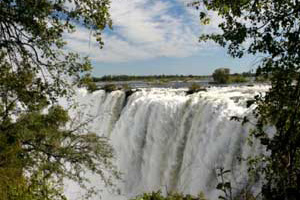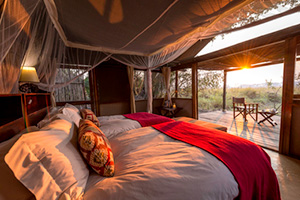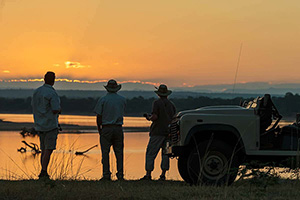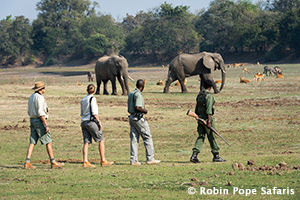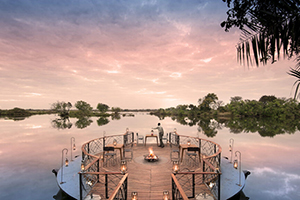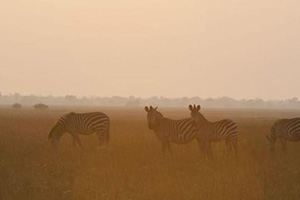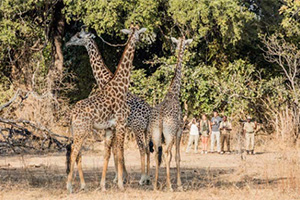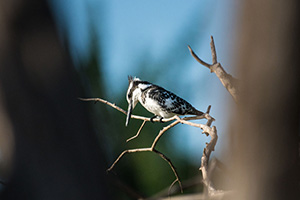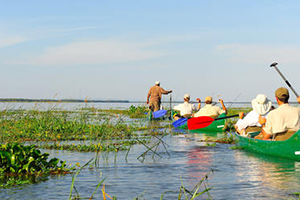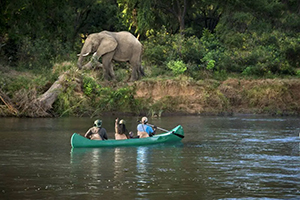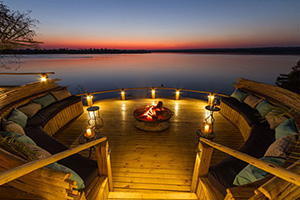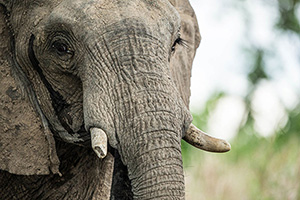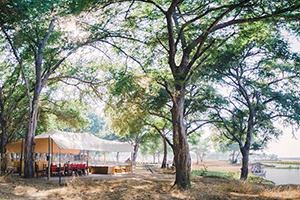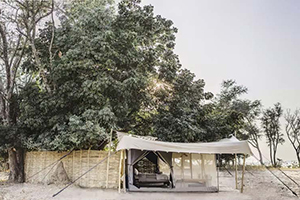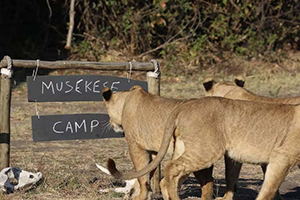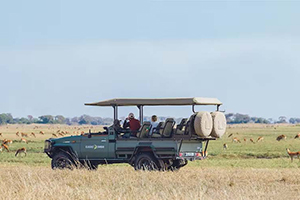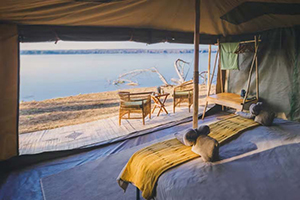Zambia Safari Attractions
Immerse yourself in Zambia, a country of mighty waters. Canoe along the Zambezi River; join a Zambia safari to the famous lakes and the most famous of waterfalls, Victoria Falls. Walking Safaris in South Luangwa National Park offers unbeatable wildlife in Africa. This is untouched Africa.
This exciting land was once called 'darkest Africa' - this is where the famous explorer David Livingstone died. For nature lovers it is a land of mighty waters. Explore on a canoe, walk through big game reserves or jump off the Victoria Falls - with a bunjy of course!
Victoria Falls
This is the most famous of the mighty waters and shared by neighboring Zimbabwe. In the C19th, the local Kololo tribe, called the Victoria Falls "the smoke that thunders", as their immense scale was so breathtaking. At the height of the wet-season five hundred and fifty million cubic metres of Zambezi river waters roar over the edge of a basalt cliff into the dramatic gorge over one hundred metres below.
This area is becoming known for adventure-sports. White-water rafting and bungy jumping are both available for those seeking an adrenaline rush. Or you can simply take a relaxing canoe trip. There is an excellent craft village nearby where you can buy beautiful green malachite which the Zambians use to create intricate jewellery. Wood carvings and other curios and crafts can be bought or or even bartered for.
The Zambezi River
The Zambezi is Africa's fourth largest River system, after the Nile, Zaire and Niger Rivers. It runs through six countries on it's journey from central Africa to the Indian Ocean. Its unique value is that it is less developed than others in terms of human settlement and many areas along it's banks enjoy protected status. It's power has carved the spectacular Victoria Falls and the zigzagging Batoka Gorge.
The Zambezi has been harnessed at various points along the way including the massive Kariba Dam between Zambia and Zimbabwe and Cabora Bassa Dam in Mozambique. Plans for another dam at the Batoka gorge have fortunately been shelved. The River's beauty has attracted tourists from all over the world providing opportunities for a myriad of water sports and game viewing.
Running for a length of 2700kms, it begins it's journey as an insignificant little spring in the corner of north-west Zambia in the Mwinilunga District. It bubbles up between the roots of a tree, very close to the border where Zambia, Angola and Zaire meet. It enters Angola for about 230kms, where it accumulates the bulk of its headwater drainage, and re-enters Zambia again at Cholwezi rapids flowing due south but substantially enlarged by the entry of various tributaries.
Lake Kariba
Lake Kariba is Zambia's undiscovered Riveira ! It offers spectacular views, stunning sunsets, great fishing, boating opportunities, water sports or wonderful relaxing holidays or weekends just soaking up the sunshine. The weather here is mostly sunny and fine. It can get quite hot in mid summer, but even mid winter days are warm and the nights are balmy.
This is Africa's largest man made dam, 226km long and in places up to 40 km wide. It provides considerable electric power to both Zambia and Zimbabwe and supports a thriving commercial fishing industry. The sheer size of it makes one forget it's a dam and in certain places it almost feels like an ocean!
A houseboat holiday is a great way to spend a few days under the sun, and the best time to plan it is over a full moon. The twilight atmosphere between sunset and full moon rise on this lake is quite magical.
Lake Tanganyika
This vast inland sea was first made known to the European world in the mid 1800's by the English explorers Richard Burton and John Speke. They pursued it as the source of the Nile, arriving at its shores in February of 1858, only to discover that the Ruzizi River in the north, which they thought to be the Nile, flowed into and not out of the lake. (Their incredible journey is documented in the movie 'Mountains of the Moon'.)
Tanganyika's waters lap Tanzania, Burundi, Congo DR and Zambia. It is the longest fresh water lake in the world and the second deepest after lake Baikal in Russia. The immense depth is because it lies in the Great Rift Valley, which also has created its steep shoreline. It reaches a depth of 1433 metres (4 700 feet), which is an astounding 642m below sea level.
Although Zambia can only lay claim to 7% of its surface area, it stretches north to south a distance of 677 kilometres (420 miles) and averages about fifty kilometers wide (31 miles). The clear waters host more than 350 different species of fish and is well known for aquarium fish exports and excellent angling.
South Luangwa National Park
Experts have dubbed South Luangwa as one of the greatest wildlife sanctuaries in the world, and not without reason. The concentration of game around the Luangwa river and it's ox bow lagoons is among the most intense in Africa.
The Luangwa River is the most intact major river system in Africa and is the life blood of the park's 9050km2. The Park hosts a wide variety of wildlife birds and vegetation. The now famous 'walking safari' originated in this park and is still one of the finest ways to experience this pristine wilderness first hand. The changing seasons add to the Park's richness ranging from dry, bare bushveld in the winter to a lush green wonderland in the summer months. There are 60 different animal species and over 400 different bird species. The only notable exception is the rhino, sadly poached to extinction.
North Luangwa National Park
This remote tract of land covering 4636 square kilometres offers one of the finest wilderness experiences in Zambia, if not Africa itself. It is not open to the public and there are no permanent lodges there. Access is with one of the few safari operators granted permission to conduct walking safaris there.
The beauty of visiting this park is the truly remarkable opportunities to experience Africa as it was. It is wild and untouched and you are simply an unobtrusive witness to its natural beauty and drama.
Lower Zambezi National Park
This Park is still relatively undeveloped, but it's beauty lies in it's absolute wilderness state. The diversity of animals is not as wide as the other big parks, but the opportunities to get close to game wandering in and out of the Zambezi channels are spectacular. The Park lies opposite the famous Mana Pools Reserve in Zimbabwe, so the whole area on both sides of the river is a massive wildlife sanctuary.
The rivers edge is overhung with a thick riverine fringe, mostly diasporus, ficus and other riverine species. Further inland is a floodplain fringed with mopane forest and interspersed with winterthorn trees Acacia albida. The hills which form the backdrop to the park are covered in broadleaf woodland.
The Lower Zambezi National Park covers an area of 4092 square kilometers, but most of the game is concentrated along the valley floor. There is an escarpment along the northern end which acts as a physical barrier to most of the parks animal species. Enormous herds of elephant, some up to 100 strong, are often seen at the rivers edge. 'Island hopping' buffalo and waterbuck are common. The park also hosts good populations of lion and leopard and listen too for the ubiquitous cry of the fish eagle.
Kafue National Park
Found in the centre of western Zambia, Kafue National Park is the oldest and largest of Zambia's national parks covering a massive 22500 Km Sq. First established as National Park in the 1950s by the legendary Norman Carr, Kafue is one of the largest national parks in the whole of Africa. Despite its size and prominent location, only two hours' drive from Livingstone, it remains little known and largely unexplored. Kafue holds possibly the greatest diversity of wildlife of any national park in Africa.
The Park is dissected roughly North to South by the Kafue River, major tributary of the Zambezi. The Kafue is a long old river that changes its moods from broad slow flowing reaches, to swift channels between tree-clothed islands and spectacular rapids before it is stemmed by Itezhi-Tezhi dam below which it opens out across the vast vistas of the Kafue Flats. Sometimes the streams that feed it have steep sandy banks that provide nesting sites for Bee Eaters and sheltered ledges and beaches that are favoured by otters, water monitors, hippo and crocodiles. The larger tributaries are the Lufupa and Lunga in the north; the Luansanza and Musa in the centre and the Nanzhila in the south. The Kafue and Musa rivers flow into Lake Itezhi-Tezhi which covers 370 km sq of tranquil water and is a haven for wildlife watchers, fisher folk (excellent fishing for bream, pike and barbel) and boating enthusiasts.
The Busanga Plain found in the north-west is regarded as the jewel in the crown of this beautiful park. Busanga is a wide flood plain which is inundated for much of the year, generating expanses of grazing and lush water meadows for thousands of red lechwe and Cape buffalo; birdlife is prolific with Spur-winged Geese, Pelicans and flocks of Open Billed storks that can be seen spiraling in the thermals over the plains rising and falling to the lagoons where they feed on snails and invertebrates in the shallows. Crowned cranes, Saddle-billed Storks and Wattled Cranes search amongst the grass for insects, frogs and small reptiles.
The Plain is also renowned for frequent sightings of lion, leopard and cheetah. The Busanga lion prides in particular are well known to the expert guides from the few safari camps that operate in this remote area and are a "must see" for any safari to Kafue. Wilderness Safaris operate very high quality camps on the Plain and offers balloon trips at certain times of the year.
In the south the Kafue runs into the Itezhi Tezhi Dam covering an area of 370 square kilometres. This vast inland sea is surrounded in parts by grassy plains, often 'mowed' by hippos. Rocky bays and stretches of submerged trees provide perfect perches for the many waterbirds inhabiting the area - fish eagles, cormorants, spoonbills and the stately goliath Heron. Elephant. buffalo, zebra and wildebeest frequent the dam. Itezhi is also an angling paradise and home to an annual fishing competition.
Information courtesy of Zambia Tourism Board


